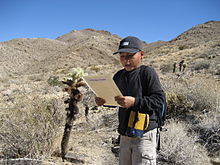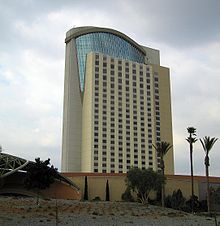Cahuilla
The Cahuilla are North American Indians in southern California . Their former residential area stretched south of the San Bernardino and San Jacinto Mountains in an inland basin made up of desert plains and rugged canyons . Acorns and mesquites , the main staple food for many Californian Indians, were only found here in sufficient quantities in well-watered areas. In addition, small game was hunted and a small amount of agriculture was carried out. Their language Ivilyuat belongs to the Uto-Aztec language family and is now almost extinct.
In 2010, 4,238 people called themselves Cahuilla.
Traditional culture and religion


The Cahuilla lived in around 50 villages with thatched huts, in sun protection huts without walls and later in adobe houses . They were skilled basket makers and potters. The villages, which could have hundreds to several thousand inhabitants, stretched over two to three kilometers - mostly in water-bearing canyons.
Culture
Their social organization was patrilinear and apparently split into two halves, moietys , which governed ancestry and marriages. There were also numerous groups and clans to which certain residential areas were assigned. Each clan had a chief ( Nét ) who performed religious and political duties and whose office was usually hereditary. The office of ritual priest ( paxa ) was also hereditary . Other key features had the mighty Necromancer ( PUUL , mostly men, which was said they dominated the supernatural life force, the weather and could evil spirits to ward off), the singer ( Háwaynik ) and the dowser ( Tet ♧ ayawiš )
religion
The traditional religion was animistic , although not all natural phenomena were considered animated, but only those that were selected by the supernatural life force ´iva´a . From this power the male twin gods Mukat and Temayawet emerged , who created the world. ´iva´a still exists and requires the preservation of the world, even if the power slowly decreases. ´iva´a is neutral, but its use can produce good or bad. By nature, spirits have more ´iva´a than humans, but the latter can increase it through ritual services or gifts received. Muut was the personification of death. The Cahuilla had a large number of religious rituals with dances and chants performed in a ritual building.
History and today's situation
The first European explorer to report on the Cahuilla was Juan Bautista de Anza , who was looking for a trade route between Sonora and Monterey in 1774. At this time it is believed to be around 2,500 people. The Christianization began with the Spanish Mission 1816. During this period some Cahuilla on Spanish were already working ranches and the Spanish-American culture influenced them sustainable. The most dramatic episode in history was the 1863 smallpox epidemic that killed many of Cahuilla's top figures. Afterwards, many survivors left their ancestral villages and moved to a few villages, the population density of which was steadily increasing. By 1870, the people's land ownership shrank due to expropriations for construction work by the SP railway company .
After the US authorities established reservations after 1877, the Cahuilla were also assigned seven reservations . Although they were able to continue their self-sufficient life there at the beginning, their dependence on American society steadily increased. The Dawes Act of 1887, which allowed the land to be subdivided and thus undermined the basis of agriculture, had dramatic consequences . In addition, there was the suppression of culture and religion by Protestant missionaries (although Catholicism clearly predominates). In 1910 the number of Cahuillas had dropped to 800 people. As a result of increasing poverty after World War II , they sold large parts of the reserve land and instead built tourist attractions in recreational areas such as Palm Springs . Some Cahuillas have prospered in well-irrigated agricultural areas, such as the Salton Sea . Many continue to work on ranches and farms, lease land (for billboards, for example) or run casinos. The remaining reserve is far from markets, water and jobs, so that unemployment there in 1995 was 78 percent.
Despite the considerable assimilation that began around 1860 and the loss of land that made the traditional collecting economy impossible, a living folklore (traditional patterns with Christian and modern elements), many socio-cultural traditions - such as the funeral rituals, relationships and social reciprocity - as well as keeping the craft of basketry. There is great interest in cultural heritage. Young Cahuilla learn their mother tongue again, old songs and the respect for ´iva´a and the spirits. Although the last ceremonial house was closed in the early 1970s, some Cahuillas still profess only traditional beliefs today. According to the ongoing surveys by the evangelical-fundamentalist conversion network Joshua Project that is still 20 percent. A Pan-Indian Powwow is held twice a year .
Federally recognized tribes of the Cahuilla
The Cahuilla were differentiated in the historical literature by anthropologists into three geographical dialect groups (they themselves did not make this distinction), which also differed culturally due to the local conditions: "Mountain (mountain)" , "Desert (desert)" and " (San Gorgonio) Pass / Western (Western) " Cahuilla.
Today there are nine Indian reservations in southern California that are home to recognized Cahuilla tribes or tribes with a predominantly Cahuilla population; these tribes are commonly referred to as bands . The reservations are located in what is now Imperial , Riverside, and San Diego Counties.
The Cahuilla bands (sometimes called "villages"):
"Pass" Cahuilla or "Western" Cahuilla (along the San Gorgonio Pass, with centers around Palms Springs and Palm Desert in the Coachella Valley , northwards to the Desert Hot Springs )
- Agua Caliente Band of Cahuilla Indians of the Agua Caliente Indian Reservation (administrative headquarters: Palm Springs, in Cahuilla: Se-Khi / Sec-he - ″ boiling water ″, hence the name of the place (and the hot springs) Agua Caliente - ″ hot water ″, several Cahuilla clans)
- Morongo Band of Cahuilla Mission Indians of the Morongo Reservation (administrative headquarters: Banning , several Cahuilla clans and Serrano , members of the Cupeño , Luiseño and Chemehuevi also belong to the tribe )
- Mission Creek Band (administrative headquarters: Desert Hot Springs, several Cahuilla clans and the eponymous mixed Cahuilla-Serrano clan Marongam (in Serrano: Morongo) as well as Serrano and some Cupeño)
"Mountain" Cahuilla ( Santa Rosa and San Jacinto Mountains )
- Cahuilla Band of Mission Indians of the Cahuilla Reservation (Administrative Headquarters : Anza )
- Ramona Band of Cahuilla Mission Indians (Administrative Headquarters: Anza)
- Los Coyotes Band of Cahuilla and Cupeno Indians of the Los Coyotes Reservation (administrative headquarters: Warner Springs , several Cahuilla clans and Cupeño)
- Santa Rosa Band of Cahuilla Indians (administrative seat: Hemet , several Cahuilla clans)
"Desert" Cahuilla (desert areas north of Lake Cahuilla (dry since the 17th century) and the Salton Sea )
- Augustine Band of Cahuilla Indians (Administrative Headquarters : Coachella )
- Cabazon Band of Mission Indians (administrative seat: Indio ), several Cahuilla clans, named after Chief Cabazon, the clan leader (Nét) of the Kauwicpameauitcem (″ Caught By the Rock People ″) clan
- Torres-Martinez Desert Cahuilla Indians (own name: ″ Mau-Wal-Mah Su-Kutt Menyil ″ - ″ Deer Moon Among the Palms ″, administrative headquarters: Thermal , several Cahuilla clans)
See also
literature
- Lowell John Bean: Mukat's People: The Cahuilla Indians of Southern California . University of California Press, Berkeley, 1972
- Robert F. Heizer (Ed.): Handbook of North American Indians , Vol. 8 California, Smithsonian Institution Press, Washington DC 1978 ISBN 0-16-004574-6 .
- AL Kroeber: Handbook of the Indians of California . Bureau of American Ethnology Bulletin No. 78.Washington, DC, 1925
- Harry C. James: The Cahuilla Indians Malki Museum Press, Banning, California, 1969
- Hansjakob Seiler: Cahuilla Grammar Malki Museum Press, Banning, California, 1977
- Hansjakob Seiler: Cahuilla Texts with an Introduction , Indiana University Publications, Bloomington, 1970
- Anna Fuchs: Morphology of the Verb in Cahuilla , de Gruyter Mouton, 1970
Web links
- Homepage of the Agua Caliente band (Engl.)
- Cahuilla (Engl.)
Individual evidence
- ↑ 2010 Census . Accessed in 2015.
- ↑ a b c d e f g h i Barry M. Pritzker: A Native American Encyclopedia. History, Culture and Peoples. Oxford University Press, New York 2000, ISBN 978-0-19-513877-1 . Pp. 119-121.
- ↑ a b c CAHUILLA . In: SOCIAL STUDIES FACT CARDS, CALIFORNIA INDIANS, Toucan Valley Publications, accessed December 31, 2015.
- ↑ a b c d Eagle Mountain Pumped Storage Project No. 13123. Response to Additional Information Request. Appendices . In: Report by the Eagle Crest Energy Company, Palm Desert (USA), 2009, accessed December 31, 2015. pp. 15–16.
- ↑ Christian F. Feest : Animated Worlds - The religions of the Indians of North America. In: Small Library of Religions , Vol. 9, Herder, Freiburg / Basel / Vienna 1998, ISBN 3-451-23849-7 . Pp. 83-84.
- ↑ Chuck Smith: ANTHRO 6 - An Introduction to California's Native People - MISSIONIZATION . ( Memento of the original from December 21, 2015 in the Internet Archive ) Info: The archive link was inserted automatically and has not yet been checked. Please check the original and archive link according to the instructions and then remove this notice. In: Cabrillo College , Aptos (USA) 1999, accessed December 31, 2015.
- ↑ Joshua Project: United States ( Memento of the original from February 19, 2016 in the Internet Archive ) Info: The archive link was inserted automatically and has not yet been checked. Please check the original and archive link according to the instructions and then remove this notice. (Cahuilla), accessed December 31, 2015.
- ^ Malki Museum
- ↑ Lowell John Bean, Sylvia Brakke Vane, and Jackson Young: The Cahuilla and the Santa Rosa Mountain region: places and their Native American associations: a review of published and unpublished sources
- ^ Mission Creek Band, Village of Indians, Mission Creek Reservation
- ^ William Duncan Strong: Aboriginal Society in Southern California
- ↑ the Spaniards called the important chief of the Desert Cahuilla Cabazon - a nickname meaning "stubborn" or "conceited, boastful"
- ^ Richard Lando &: Ruby E. Modesto: Temal Wakhish: A Desert Cahuilla Village
- ^ Edward Winslow Gifford: Clans and Moities in Southern California
- ↑ Larea Lewis: The Desert Cahuilla: A Study of Cultural Landscapes and Historic Settlements



